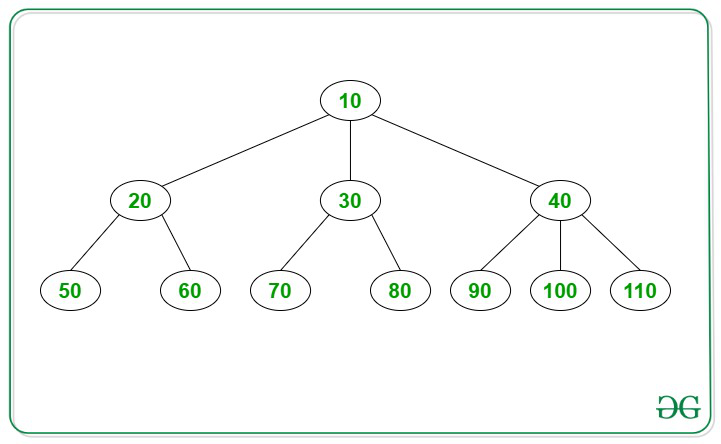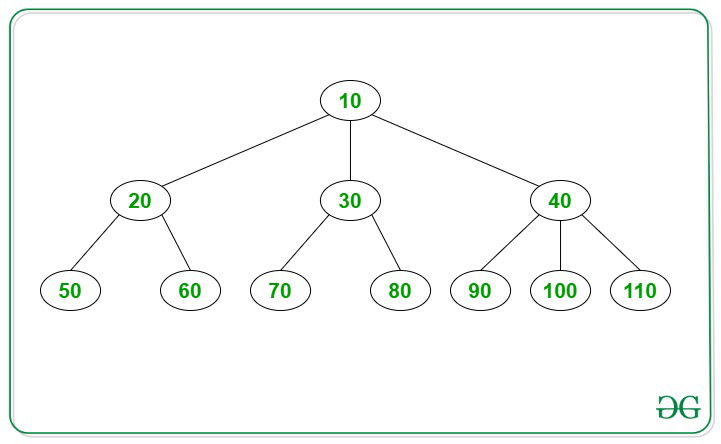给定一个N 叉树和一个元素X ,任务是打印值为X的节点的兄弟节点。
Two nodes are considered to be siblings if they are present at the same level and have the same parent.
例子:
Input: X = 100

Output: 90 110
Explanation: Nodes valued 90, 100 and 110 have the same parent, i.e. the node valued 40. Therefore, nodes 90 and 110 are the siblings of the given node X( = 100).
Input: X = 30

Output: 20 40
Explanation: Nodes valued 20, 30 and 40 have the same parent, i.e. the node valued 10. Therefore, nodes 20 and 40 are the siblings of the given node X( = 30).
方法:按照下面给出的步骤解决问题:
- 在给定的N叉树上执行层序遍历。
- 初始化队列q以进行层序遍历。
- 对于遇到的每个节点,将其所有子节点推入队列。
- 在将当前节点的孩子推入队列时,检查:这些孩子中的任何一个是否等于给定的值X。如果发现为真,则打印除X之外的所有节点,这些节点是当前节点的子节点作为所需答案。
- 否则,继续遍历树。
下面是上述方法的实现:
C++
// C++ program for the above approach
#include
using namespace std;
// Structure of a node of N-ary tree
struct Node {
int key;
vector child;
};
// Function to create a new node
Node* newNode(int key)
{
Node* temp = new Node;
temp->key = key;
return temp;
}
// Function to find the siblings
// of the node value
void Siblings(Node* root, int value)
{
int flag = 0;
if (root == NULL)
return;
// Stores nodes level wise
queue q;
// Push the root
q.push(root);
// Continue until all levels
// are traversed
while (!q.empty()) {
// Stores current node
Node* temp = q.front();
q.pop();
// Enqueue all children of the current node
for (int i = 0; i < temp->child.size(); i++) {
// If node value is found
if (temp->child[i]->key == value) {
flag = 1;
// Print all children of current node
// except value as the answer
for (int j = 0; j < temp->child.size();
j++) {
if (value
!= temp->child[j]->key)
cout << temp->child[j]->key
<< " ";
}
break;
}
// Push the child nodes
// of temp into the queue
q.push(temp->child[i]);
}
}
if (flag == 0)
cout << "No siblings!!";
}
Node* constructTree()
{
Node* root = newNode(10);
(root->child).push_back(newNode(20));
(root->child).push_back(newNode(30));
(root->child).push_back(newNode(40));
(root->child[0]->child).push_back(newNode(50));
(root->child[0]->child).push_back(newNode(60));
(root->child[1]->child).push_back(newNode(70));
(root->child[1]->child).push_back(newNode(80));
(root->child[2]->child).push_back(newNode(90));
(root->child[2]->child).push_back(newNode(100));
(root->child[2]->child).push_back(newNode(110));
return root;
}
// Driver Code
int main()
{
// Stores root of the
// constructed tree
Node* root = constructTree();
int X = 30;
// Print siblings of Node X
Siblings(root, X);
return 0;
} Java
// Java program for the
// above approach
import java.util.*;
class GFG{
// Structure of a node
// of N-ary tree
static class Node
{
int key;
Vector child =
new Vector<>();
};
// Function to create a
// new node
static Node newNode(int key)
{
Node temp = new Node();
temp.key = key;
return temp;
}
// Function to find the
// siblings of the node
/// value
static void Siblings(Node root,
int value)
{
int flag = 0;
if (root == null)
return;
// Stores nodes level wise
Queue q =
new LinkedList<>();
// Push the root
q.add(root);
// Continue until all
// levels are traversed
while (!q.isEmpty())
{
// Stores current node
Node temp = q.peek();
q.remove();
// Enqueue all children
// of the current node
for (int i = 0;
i < temp.child.size();
i++)
{
// If node value is found
if (temp.child.get(i).key ==
value)
{
flag = 1;
// Print all children of current
// node
// except value as the answer
for (int j = 0;
j < temp.child.size();
j++)
{
if (value !=
temp.child.get(j).key)
System.out.print(
temp.child.get(j).key + " ");
}
break;
}
// Push the child nodes
// of temp into the queue
q.add(temp.child.get(i));
}
}
if (flag == 0)
System.out.print("No siblings!!");
}
static Node constructTree()
{
Node root = newNode(10);
(root.child).add(newNode(20));
(root.child).add(newNode(30));
(root.child).add(newNode(40));
(root.child.get(0).child).add(newNode(50));
(root.child.get(0).child).add(newNode(60));
(root.child.get(1).child).add(newNode(70));
(root.child.get(1).child).add(newNode(80));
(root.child.get(2).child).add(newNode(90));
(root.child.get(2).child).add(newNode(100));
(root.child.get(2).child).add(newNode(110));
return root;
}
// Driver Code
public static void main(String[] args)
{
// Stores root of the
// constructed tree
Node root = constructTree();
int X = 30;
// Print siblings of Node X
Siblings(root, X);
}
}
// This code is contributed by Rajput-Ji C#
// C# program for the
// above approach
using System;
using System.Collections.Generic;
class GFG{
// Structure of a node
// of N-ary tree
public class Node
{
public int key;
public List child =
new List();
};
// Function to create a
// new node
static Node newNode(int key)
{
Node temp = new Node();
temp.key = key;
return temp;
}
// Function to find the
// siblings of the node
/// value
static void Siblings(Node root,
int value)
{
int flag = 0;
if (root == null)
return;
// Stores nodes level
// wise
Queue q =
new Queue();
// Push the root
q.Enqueue(root);
// Continue until all
// levels are traversed
while (q.Count != 0)
{
// Stores current node
Node temp = q.Peek();
q.Dequeue();
// Enqueue all children
// of the current node
for (int i = 0;
i < temp.child.Count; i++)
{
// If node value is found
if (temp.child[i].key == value)
{
flag = 1;
// Print all children of
// current node except value
// as the answer
for (int j = 0;
j < temp.child.Count; j++)
{
if (value != temp.child[j].key)
Console.Write(temp.child[j].key + " ");
}
break;
}
// Push the child nodes
// of temp into the queue
q.Enqueue(temp.child[i]);
}
}
if (flag == 0)
Console.Write("No siblings!!");
}
static Node constructTree()
{
Node root = newNode(10);
(root.child).Add(newNode(20));
(root.child).Add(newNode(30));
(root.child).Add(newNode(40));
(root.child[0].child).Add(newNode(50));
(root.child[0].child).Add(newNode(60));
(root.child[1].child).Add(newNode(70));
(root.child[1].child).Add(newNode(80));
(root.child[2].child).Add(newNode(90));
(root.child[2].child).Add(newNode(100));
(root.child[2].child).Add(newNode(110));
return root;
}
// Driver Code
public static void Main(String[] args)
{
// Stores root of the
// constructed tree
Node root = constructTree();
int X = 30;
// Print siblings of Node X
Siblings(root, X);
}
}
// This code is contributed by Rajput-Ji 输出:
20 40
时间复杂度: O(N 2 )
辅助空间: O(N)
如果您想与行业专家一起参加直播课程,请参阅Geeks Classes Live